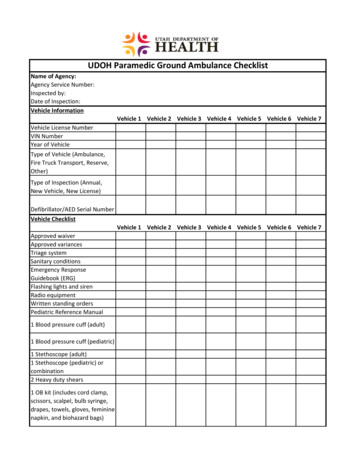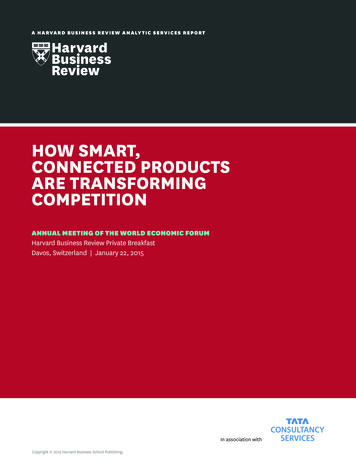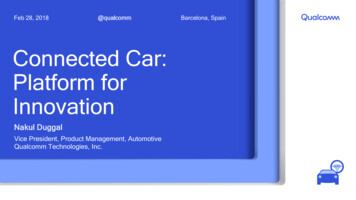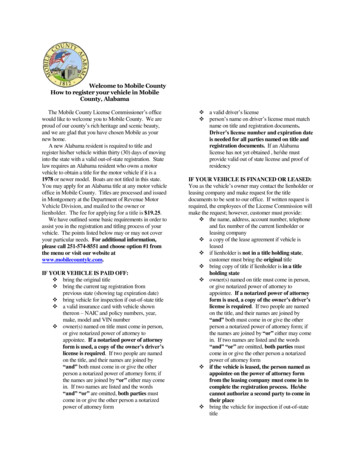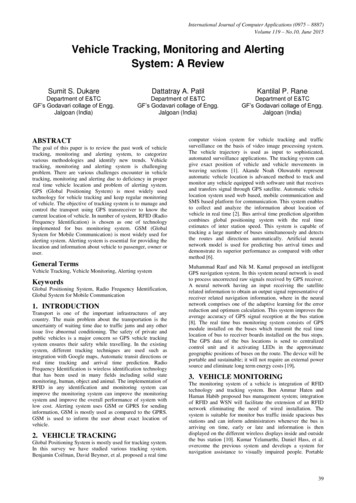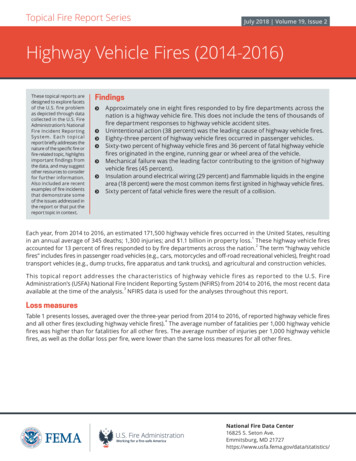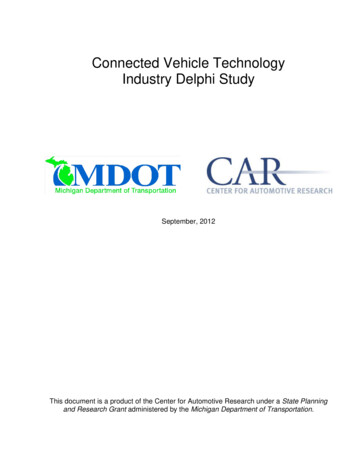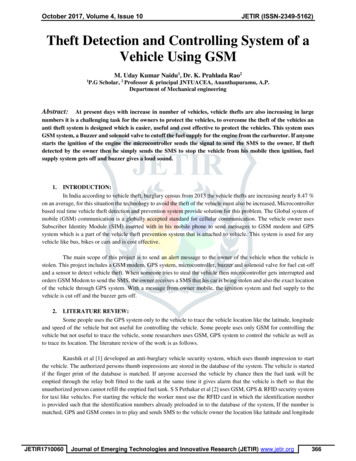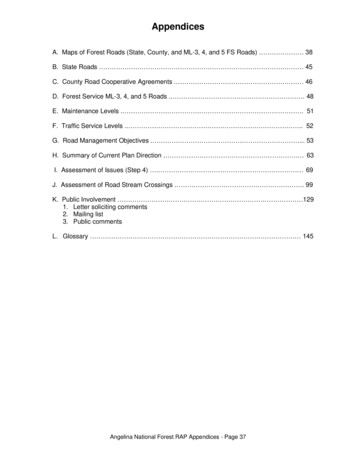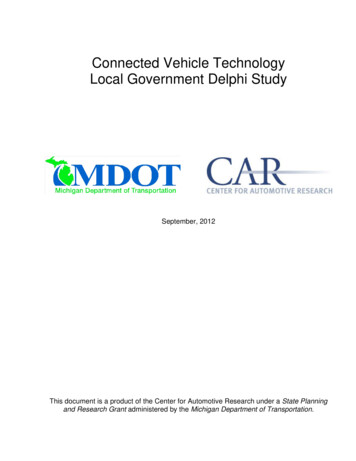
Transcription
Connected Vehicle TechnologyLocal Government Delphi StudySeptember, 2012This document is a product of the Center for Automotive Research under a State Planningand Research Grant administered by the Michigan Department of Transportation.
CONNECTED VEHICLE TECHNOLOGY LOCAL GOVERNMENT DELPHI STUDYTable of ContentsExecutive Summary . 3Highlights of Findings . 3I. Introduction . 5Delphi Survey Methods. 5II. Public Sector Connected Vehicle Survey Results . 7Type of Technology . 7DSRC and Cooperative, Active Safety Systems . 73G and 4G for All Other Applications . 7DSRC and Traffic Incident Information . 7Communication Technology and Primary Communication Pipeline between Vehiclesand Infrastructure . 8Connected Vehicle Technology and Backhaul Options . 9V2V vs. V2I Technology . 10V2V-Only System . 10V2V and V2I and Applications . 10V2I Technology Implementation . 11Public Sector and Connected Vehicle Technology . 12Highest Priority Uses of Connected Vehicle Technology for the Public Sector . 12Sharing Data with Public Agencies . 13DOT Cost Schemes to Obtain Probe Data . 13Roadside Infrastructure Needs . 13Transmission Modes at Roadside Locations . 13Bluetooth Technology and Probe Data. 14DSRC Infrastructure Needed for In-Vehicle Installation . 14Traffic Management Systems Necessary for Successful National Deployment . 15NHTSA Regulatory Decision . 15NHTSA Mandate . 16Years for All Vehicles to Have Technology as Standard Equipment . 16Mandating Existing Vehicles to be Retrofit with Technology . 16Encouraging Current Owners to Retrofit Vehicles . 16Likelihood of Automaker Pursuit of V2V Technology . 17Other Governmental Mandates . 17Federal Mandates for V2V Applications . 17State Mandates for V2I Applications . 17Challenges to Broad Adoption . 17Challenges to Broad Adoption of Connected Vehicle Technology . 18III. Conclusions . 24References. 25Appendix A: First- and Second-Round Industry Delphi Survey Questions . 262MICHIGAN DEPARTMENT OF TRANSPORTATION & THE CENTER FOR AUTOMOTIVE RESEARCH
CONNECTED VEHICLE TECHNOLOGY LOCAL GOVERNMENT DELPHI STUDYEXECUTIVE SUMMARYThe automotive industry continues to transform from being predominantly mechanicallybased to increasingly electronically-based.This transformation is critical to the State ofMichigan as it seeks to maintain its positionas a global leader in the automotive sector.The Michigan economy lost more than460,000 jobs from 2007 to 2010; however, itappears to be headed towards a recovery,gaining more than 140,000 jobs between2011 and 2012 to-date (Bureau of Labor Statistics, 2012). Connected vehicle technologydevelopment offers Michigan a growing hightech industry where Michigan companies already have a competitive advantage. Michigan is also home to the Michigan Department of Transportation (MDOT) and otherpublic-sector agencies that have demonstrated national leadership in connected vehicles. MDOT is pursuing a strategy for supporting the testing and development of connected vehicle technologies that keep driversconnected, save lives, improve mobility, protect the environment, and employ Michiganresidents.MDOT asked the Center for Automotive Research (CAR) to perform surveys of expertopinion, with panelists from the automotiveand public sectors, to help forecast the futureof connected vehicle technology researchand deployment. In response to this request,CAR conducted a follow-up to its expert panel surveys from 2005 and 2008 to ascertainchanges in the strategic direction of the connected vehicle and wireless communicationtechnology industries. This follow-up studyalso discerns new technical and public needsemerging in this field.This report summarizes the public sectorsurvey results. In particular, it provides ageneral overview of user services and surveyresults in several categories: Type of Technology Vehicle-to-Vehicle (V2V) vs. Vehicle-toInfrastructure (V2I) Technology Public Sector and Connected Vehicles Roadside Infrastructure Needs National Highway Transportation SafetyAdministration (NHTSA) 2013 Notice ofRegulatory Intent Other Government Policy Implications Challenges to Broad Adoption of TechnologyHIGHLIGHTS OF FINDINGSRespondents overwhelmingly reaffirmed theconsensus that Dedicated Short RangeCommunication (DSRC) is needed for cooperative, active safety systems, while thirdgeneration (3G) and fourth generation (4G)cellular communications tend to be viewedas appropriate for many other applications.Respondents also indicated that 3G and 4Gcellular technology will be the primary communication pipeline for probe data collection,fleet management, commercial and privateapplications, and asset management, whileDSRC will be used for in-vehicle warnings.Respondents also indicated that DRSC iscapable of providing traffic incident information.Most respondents answered that, while aV2V-only system is possible, it is undesirable, because V2V must be combined withV2I systems to maximize public benefit.Nonetheless, V2V systems are seen as easier to implement; therefore, concerted effortwill likely have to be made to ensure appropriate V2I systems are also in place. Thisfinding stands out in that the respondents forthis survey largely represent public agencies.According to respondents, the highest priorityuse of connected vehicle technology for thepublic sector is crash avoidance. Given thatone of the public sectors’ main charges is toenhance safety, this is not surprising. Respondents are unsure whether automakerswill share sensor data with agencies, butthey indicated that a public/private partner-MICHIGAN DEPARTMENT OF TRANSPORTATION & THE CENTER FOR AUTOMOTIVE RESEARCH3
CONNECTED VEHICLE TECHNOLOGY LOCAL GOVERNMENT DELPHI STUDYship would be the best way to encourage thissharing.Respondents indicated that DSRC is the likely transmission mode for infrastructure usedin urban intersections, and correspondingly,intersection safety is seen as the highest necessity to make in-vehicle installation ofDSRC worthwhile. Cellular technology is themore likely transmission mode for urbanhighways. For a successful national deployment, both Traffic Management Centers andNetworked Traffic Signal Systems areviewed as essential by the respondents.Public sector respondents overwhelminglythink that the potential NHTSA Notice ofRegulatory Intent in 2013 will be in the affirmative, and if it is, that it will take five ormore years for all vehicles to be required tohave the safety technology installed asstandard equipment. While they do not be-4lieve existing vehicles will be required tohave aftermarket retrofits, they concur thatnot requiring retrofits will significantly degrade overall system performance, becauselacking a mandate for retrofits, until there issignificant fleet turnover, most vehicles onthe road will not have the safety technologyfor some years after a new vehicle mandategoes into effect. Offering some type of consumer incentive is seen as the best way toencourage drivers to retrofit their own vehicles with the technology. Respondents donot expect federal or state mandates of V2Iapplications. This, too, may be viewed aslimiting overall system performance.According to the respondents, the biggestchallenge to broad adoption of the technology is procuring enough funding to deploy infrastructure along roadways.MICHIGAN DEPARTMENT OF TRANSPORTATION & THE CENTER FOR AUTOMOTIVE RESEARCH
CONNECTED VEHICLE TECHNOLOGY LOCAL GOVERNMENT DELPHI STUDYI. INTRODUCTIONRoad transportation continues to undergosignificant technological transformations aswireless communication increasingly enablesvehicles to communicate with each other andwith the infrastructure. This has multiplebenefits, including improved safety, mobility,personal convenience, and economic development. To make the most of this opportunity, public and private entities must collaborate to develop a system that actively engages the automotive, telecommunications, andconsumer electronics industries. The challenge lies in building enough confidence onboth the public and private sides of the issueto bring them together to cooperate andachieve an integrated outcome.One of the primary benefits of connected vehicle technology is the potential for vastly improved vehicle safety. Both vehicle-to-vehicle(V2V) and vehicle-to-infrastructure (V2I)communication promise significant safetyimprovements.Assuming a DedicatedShort-Range Communication (DSRC)-basedsafety system, vehicles continuously (tentimes per second) broadcast a basic safetymessage that includes information such asvehicle speed, heading and location. Thisinformation is cooperatively used by otherequipped vehicles so that crashes are avoided. In the V2I realm, safety is enhanced viabroadcast of signal phase and timing (SPaT)information at signalized intersections, andthis information can be used to warn driversabout vehicle about to run a red light, to actively prevent red-light running, and to recommend travel speeds so as to create greenwaves, among other possible intersectionapplications.In addition to safety benefits, connected vehicle technology also helps with traffic operations. Equipped vehicles will serve as trafficprobes, communicating information abouttravel speed to assist in the detection of congestion and incidents. This information canthen be shared with vehicles that are not yetin the traffic stream, allowing drivers tochoose a different route.The connected vehicle is a central component of the public-private partnership in sustaining technological development in theMichigan automotive sector. Consumers areconnected in almost every domain of life,from home to work, or any other locationwhere there is access to cell phones and WiFi communication.To inform the department’s connected vehicle activities, the Michigan Department ofTransportation (MDOT) asked the Center forAutomotive Research (CAR) to perform twoDelphi studies to augment previous researchdone on connected vehicle technology and toprovide insights into private- and publicsector views on the future of the technologies. This report focuses on the public sector study and presents both methods used inthe study and the findings resulting from it,along with conclusions.DELPHI SURVEY METHODSAlthough several more were asked to andagreed to participate, ultimately seventeenrespondents participated in the first roundand fifteen participated in the second roundof the study. Public sector panelists camefrom state Departments of Transportation(DOTs), local DOTS, and engineering andother firms that provide services to publicsector agencies. The panelists (respondents) were informed that the process isanonymous, and that their participation andtheir specific answers tied to their identitywould not be shared with anyone outside theresearch team. Additionally, in lieu of compensation for participating in the study, respondents were given the raw, unanalyzedresults for each survey in which they participated. Participants were drawn from the following organizations: American Association of State Highway andTransportation Offices (AASHTO)MICHIGAN DEPARTMENT OF TRANSPORTATION & THE CENTER FOR AUTOMOTIVE RESEARCH5
CONNECTED VEHICLE TECHNOLOGY LOCAL GOVERNMENT DELPHI STUDY Booz Allen Hamilton CalTrans HNTB Michigan Department of Transportation Minnesota Department of Transportation National Highway Transportation SafetyAdministration New York Department of Transportation Ohio Department of Transportation Parsons Brinkerhoff Road Commission for Oakland County SAIC Southeast Michigan Council of Governments Texas Department of Transportation6 Transport CanadaThe respondents, or panelists, were giventwo, iterative surveys to complete, with thesecond survey arriving several weeks afterthe first. The questions included in the surveys addressed a broad range of topics, including communication technologies for various applications, possible governmental influence, and roadside infrastructure neededfor a successful deployment. Other, moretechnology-specific topics included appropriate transmission modes at roadside locations, how V2V and V2I systems compare,and which communication pipelines will bestserve various applications.MICHIGAN DEPARTMENT OF TRANSPORTATION & THE CENTER FOR AUTOMOTIVE RESEARCH
CONNECTED VEHICLE TECHNOLOGY LOCAL GOVERNMENT DELPHI STUDYII. PUBLIC SECTOR CONNECTED VEHICLE SURVEY RESULTSThe results of the survey include questionsasked on only one of the two survey roundsand questions asked in both rounds and include a range of technology topics. Forquestions that were repeated, the discussiontends to focus on second-round results,though the first-round often is used to extendthe discussion.TYPE OF TECHNOLOGYOne discussion in the connected vehiclerealm is which types of technology best fitwhich types of applications. Respondentsreaffirmed the consensus that DedicatedShort Range Communication (DSRC) isneeded for cooperative, active safety systems, while third generation (3G) and fourthgeneration (4G) cellular technology tend tobe thought of as appropriate for other applications.DSRC AND COOPERATIVE, ACTIVE SAFETYSYSTEMSpressed the view that DSRC is needed forcooperative, active safety systems, as shownin Figure 1.3G AND 4G FOR ALL OTHER APPLICATIONSAs Figure 2 shows, while the consensus isnot as firm as with DSRC and safety systems, 63 percent of respondents agree orstrongly agree that 3G and 4G cellular technology can handle other connected vehicleapplications, while only 19% disagree.DSRC AND TRAFFIC INCIDENT INFORMATIONResponses from the first round were split regarding whether DSRC-based connectedvehicle systems will support the requiredtwo-way communication systems to delivertraffic incident information and similar publicwarnings to the vehicle. When asked again inthe second round, however, respondentswere more definitive that they think DSRCwill at least be capable of providing traffic incident information. (See Figure 3.)More than 90 percent of respondents ex-Figure 1: DSRC Needed for Cooperative, Active Safety SystemsSource: CAR 2012MICHIGAN DEPARTMENT OF TRANSPORTATION & THE CENTER FOR AUTOMOTIVE RESEARCH7
CONNECTED VEHICLE TECHNOLOGY LOCAL GOVERNMENT DELPHI STUDYCOMMUNICATION TECHNOLOGY ANDPRIMARY COMMUNICATION PIPELINEBETWEEN VEHICLES AND INFRASTRUCTURERespondents see 3G and 4G cellular technology as the primary communication pipeline for probe data collection, fleet management, commercial and private applications,and asset management (see Figure 4).DSRC is primarily thought of for in-vehiclewarnings, and radio frequency identification(RFID) technology is thought best for tollsand electronic payments.As Figure 5 shows, in 2022, the major difference that respondents see is that DSRC andcellular technology will have an increasedFigure 2: 3G and 4G for All Other ApplicationsSource: CAR 2012Figure 3: DSRC and Traffic Incident InformationSource: CAR 20128MICHIGAN DEPARTMENT OF TRANSPORTATION & THE CENTER FOR AUTOMOTIVE RESEARCH
CONNECTED VEHICLE TECHNOLOGY LOCAL GOVERNMENT DELPHI STUDYrole in tolls and electronic payments.CONNECTED VEHICLE TECHNOLOGY ANDBACKHAUL OPTIONSThe majority of respondents agree or strong-ly agree that connected vehicle technologywill be sufficiently flexible to allow a variety ofcommunication backhaul options (e.g., fiberoptic, cellular, other wireless etc.), as shownin Figure 6.)Figure 4: Communication Technology and Primary Communication Pipeline in 2017Source: CAR 2012Figure 5: Communication Technology and Primary Communication Pipeline in 2022Source: CAR 2012MICHIGAN DEPARTMENT OF TRANSPORTATION & THE CENTER FOR AUTOMOTIVE RESEARCH9
CONNECTED VEHICLE TECHNOLOGY LOCAL GOVERNMENT DELPHI STUDYV2V VS. V2I TECHNOLOGYAnother discussion in the connected vehiclerealm is which is most valuable and realistic:vehicle-to-vehicle (V2V) communication,whereby vehicles communicate directly witheach other, or vehicle-to-infrastructure (V2I)communication, whereby vehicles communicate with roadside infrastructure. Most respondents indicated that V2V and V2I working cooperatively is the best system to maximize public good.V2V-ONLY SYSTEMRespondents were asked whether a V2Vonly system is possible, and 63 percent replied that yes, it is, but 88 percent indicatedthat such a system is not desirable. (SeeFigures 7 and 8.)V2V-only is undesirable, because it cannotextend the same benefits as a combinedV2V/V2I system. Some respondents statethat if V2I is not taken up by public sector,V2V-only will be deployed by automakers,and V2I will be difficult since no one agencycontrols all the infrastructure and a NHTSAmandate will not require V2I applications onthe vehicle.In addition, with the current funding constraints, unknown infrastructure performance,and operational requirements, deployment ofV2V-only seems to be the simplest approach, even if it is not the most beneficial.Some respondents believe that some infrastructure is needed for the security component of the V2V system, but others suggestthat this could be done using another systemsuch as cell phone networks or secure Wi-Ficonnections.V2V AND V2I AND APPLICATIONSIn the first-round survey, respondents wereasked whether V2V or V2I communicationwill be more important for a variety of applications in 2017 and 2022. Open-ended responses indicated we should address twomore applications; therefore, in the secondround, we asked about those two specifically.The combined responses are shown in Figure 9. The public sector respondents clearlythink V2I is more important for most applications, both in 2017 and 2022. The one exception to this is for safety applications; forthese, for both years, V2V is viewed as moreFigure 6: Connected Vehicle Technology and Backhaul OptionsSource: CAR 201210MICHIGAN DEPARTMENT OF TRANSPORTATION & THE CENTER FOR AUTOMOTIVE RESEARCH
CONNECTED VEHICLE TECHNOLOGY LOCAL GOVERNMENT DELPHI STUDYimportant.V2I TECHNOLOGY IMPLEMENTATIONAs Figure 10 shows, respondents believemore connected vehicle technology featureswill be implemented via V2I technology astime goes on. In 2017, the only features thatabout half of respondents thought would beimplemented with V2I were road conditionwarnings and traveler information. Conversely, by 2022, the majority of respondents indicate that all features will be im plemented viaV2I technology. Thus, they see a gradualevolution toward greater reliance on V2Itechnology over time.Figure 7: V2V-Only System PossibilitySource: CAR 2012Figure 8: V2V-Only System DesirabilitySource: CAR 2012MICHIGAN DEPARTMENT OF TRANSPORTATION & THE CENTER FOR AUTOMOTIVE RESEARCH11
CONNECTED VEHICLE TECHNOLOGY LOCAL GOVERNMENT DELPHI STUDYPUBLIC SECTOR AND CONNECTED VEHICLE TECHNOLOGYThe public sector faces some unique challenges and goals when it comes to connected vehicle technology, as described below.Not surprisingly, the highest priority use ofconnected vehicle technology for most publicsector respondents was safety-related, specifically crash avoidance.HIGHEST PRIORITY USES OF CONNECTEDVEHICLE TECHNOLOGY FOR THE PUBLICSECTORRespondents indicated that the highest priority use of connected vehicle technology forthe public sector is crash avoidance. Trafficmanagement and then asset managementfollow, as Figure 11 shows.Figure 9: V2V and V2I and ApplicationsSource: CAR 201212MICHIGAN DEPARTMENT OF TRANSPORTATION & THE CENTER FOR AUTOMOTIVE RESEARCH
CONNECTED VEHICLE TECHNOLOGY LOCAL GOVERNMENT DELPHI STUDYSHARING DATA WITH PUBLIC AGENCIESFirst-round responses were mixed as towhether automakers would share vehiclesensor data with public agencies to supportpublic applications and services, such as asset management and road weather information. In the second round, respondentswere asked which approaches might encourage automakers to share these data. Respondents were encouraged to select all thatapply, and as Figure 12 shows, most think apublic/private partnership would best encourage data sharing, followed by a mandate.DOT COST SCHEMES TO OBTAIN PROBEDATAIn general, respondents expressed the viewthat DOTs will have to pay for data. Respondent answers suggest that a data quantity-based fee is the most likely scenario toobtain probe data from aggregators and resellers. But 20 percent of respondents alsosaw the potential for a flat service fee, and20 percent thought there may be no charge.Other written-in responses included the possibility for a flat fee for basic data with incremental increases for additional information,that users will likely buy information ratherthan data, and that the price will be based onquantity and frequency. Figure 13 displaysthese results.ROADSIDE INFRASTRUCTURE NEEDSConnected vehicle technology infrastructurealong the roadside is of particular importanceto the public sector as DOTs will likely be responsible for installing it. Respondents primarily think DSRC technology is the mostlikely to be used for urban intersections, andintersection safety is one of the primary benefits to make in-vehicle installation of DSRCworthwhile.TRANSMISSION MODES AT ROADSIDELOCATIONSAs Figure 14 shows, respondents thinkDSRC is most likely for urban intersections,and cellular technology is most likely for urban highways. Responses were less concrete for the transmission mode at toll roads,Figure 10: V2I Technology ImplementationSource: CAR 2012MICHIGAN DEPARTMENT OF TRANSPORTATION & THE CENTER FOR AUTOMOTIVE RESEARCH13
CONNECTED VEHICLE TECHNOLOGY LOCAL GOVERNMENT DELPHI STUDYthough a slight majority indicated that it willbe RFID.BLUETOOTH TECHNOLOGY AND PROBEDATAA slight majority of respondents, 53 percent,believe that Bluetooth technology deployedalong the roadside would be somewhat useful for collecting traffic probe information. Butin general, there is not much certainty thatthe technology would be a benefit. (See Fig-ure 15.)DSRC INFRASTRUCTURE NEEDED FOR INVEHICLE INSTALLATIONIn the first round, respondents were asked todescribe the characteristics (e.g., extent, location, etc.) of the DSRC infrastructure thatthey think are necessary to make in-vehicleinstallation of DSRC worthwhile. Severalitems were mentioned, but the most commonresponses dealt with intersection safety,Figure 11: Highest Priority Uses of Connected Vehicle Technology forthe Public SectorSource: CAR 2012Figure 12: Sharing Data with Public AgenciesSource: CAR 201214MICHIGAN DEPARTMENT OF TRANSPORTATION & THE CENTER FOR AUTOMOTIVE RESEARCH
CONNECTED VEHICLE TECHNOLOGY LOCAL GOVERNMENT DELPHI STUDYsafety at select non-intersection areas, suchas curves and road construction, and network security. When asked about these threeitems in the second round, intersection safetywas deemed most important, followed bynetwork security and then safety at selectnon-intersection areas. Figure 16 displaysthese results.TRAFFIC MANAGEMENT SYSTEMSNECESSARY FOR SUCCESSFUL NATIONALDEPLOYMENTIn the first round, respondents were askedthe extent to which they agree with the following statement: Further development of the following trafficmanagement systems are essential to asuccessful national deployment of connected vehicle technology.o Roadside and/or embedded highway sensorso Roadside video cameraso Traffic management centerso Networked traffic signal systemso Electronic toll collection systemsAs Figure 17 displays, there was generalagreement that Traffic Management Centers(TMCs) and Networked Traffic Signal Systems are essential to national deployment,but roadside sensors and videos are not.In the second round survey, respondentswere asked the extent to which they agreethat, despite V2I, TMCs and Networked Traffic Signal Systems are essential to a successful national deployment of connectedvehicle technology. Respondent answers indicate that both are necessary to achieve thenational deployment goal (see Figure 18).NHTSA REGULATORY DECISIONOne of the most impactful decisions on thehorizon is whether or not the National Highway Safety and Transportation Administration (NHTSA) will announce its intent tomandate V2V communication systems forsafety applications in 2013. It is widely believed that if they do, it will spur deploymentof the technology, though it will take severalyears for the regulatory process to play out.Although NHTSA has announced that it willmake a Notice of Regulatory Intent (NRI)about this in 2013, the direction of the noticeFigure 13: DOT Cost Schemes to Obtain Probe DataSource: CAR 2012MICHIGAN DEPARTMENT OF TRANSPORTATION & THE CENTER FOR AUTOMOTIVE RESEARCH15
CONNECTED VEHICLE TECHNOLOGY LOCAL GOVERNMENT DELPHI STUDYis not known at this time, and the agency also might delay its decision. Never announcing a decision at all would be a de facto no.NHTSA MANDATERespondents overwhelming think thatNHTSA’s likely NRI will be in the affirmative(i.e., that it does intend to mandate V2V safety technology), as shown in Figure 19.YEARS FOR ALL VEHICLES TO HAVETECHNOLOGY AS STANDARD EQUIPMENTThe majority of respondents (88 percent) indicated that, if NHTSA announces that itdoes intend to mandate safety technology, itwill take five or more years for all new vehicles to be required to have the technology asstandard equipment (see Figure 20).MANDATING EXISTING VEHICLES TO BERETROFIT WITH TECHNOLOGYRespondents indicated that it is highly unlikely that, even if NHTSA mandates safetytechnology, it will also require existing vehi-cles to be retrofitted with an aftermarket device. (See Figure 21.)Despite this view, respondents strongly believe that not requiring vehicle retrofits ofconnected vehicle technology will cause degradation of system performance. Seventyone percent expressed the view that thisdegradation would be significant, and theremaining 29 percent responded that it wouldbe moderate. No respondents answered thatit would be slightly or not at all degrading tosystem performance. (See Figure 22.)ENCOURAGING CURRENT OWNERS TORETROFIT VEHICLESBy selecting all that apply respondents wereasked the best ways to encourage customersto voluntarily retrofit their vehicles should aNHTSA notice of regulatory intent be affirmative. Figure 23 shows clearly that respondents view consumer incentives as the bestencouragement to make this happen. Thosewho selected Other specified primarily con-Figure 14: Transmission Modes at Roadside LocationsSource: CAR 201216MICHIGAN DEPARTMENT OF TRANSPORTATION & THE CENTER FOR AUTOMOTIVE RESEARCH
CONNECTED VEHICLE TECHNOLOGY LOCAL GOVERNMENT DELPHI STUDYsumer incentives, though they often specifiedfeatures rather than direct monetary compensation (e.g., insurance cost reduction,telematics/geo-location services and applications that users want, HOV access, and freeretrofits). One respondent suggested a regulation requiring basic safety messaging abilities along with license renewal.LIKELIHOOD OF AUTOMAKER PURSUIT OFV2V TECHNOLOGYRespondents were split on issue of whetheror not automakers will continue to pursueV2V technolog y development if NHTSAchoices not to mandate V2V safety technology. As Figure 24 shows, none thinks it is verylikely that the auto industry would continue,but the remaining responses were spreadrelatively evenly over the o
Both vehicle-to-vehicle (V2V) and vehicle-to-infrastructure (V2I) communication promise significant safety improvements. Assuming a Dedicated Short-Range Communication (DSRC)-based safety system, vehicles continuously (ten times per second) broadcast a basic safety message that includes information such as vehicle speed, heading and location. This
